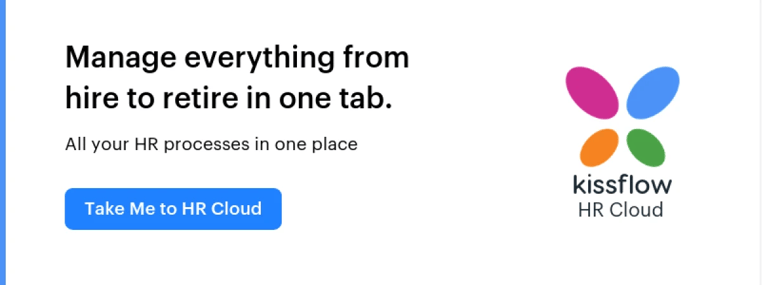Smart businesses don’t have time to waste completing basic and repetitive HR tasks manually or following the same lengthy processes time and time again. By investing in a Human Resources Management System (HRMS Software), though, they can quickly and easily automate these time-consuming and tedious activities, allowing HR teams to focus on more value-adding activities.
What is HRMS software?
HRMS software is a platform that integrates, manages, and automates many of the routine HR processes in an organization. It can perform a variety of functions including organizing and managing employee details and organizational information of a business, making it easily accessible—similar to how an employee onboarding automation simplifies the onboarding experience for new hires.
As popularity for HRMS software has grown, there are many different systems on the market including Human Capital Management (HCM) and Human Resource Information System (HRIS), each offering varying features and functionalities—such as payroll integration, performance tracking, and travel and expense management—at different price points.
Understanding the difference between HRMS, HRIS, and HCM
All three of these describe systems that use the power of cloud tech and information databases to control workforce management. Vendors, analysts and marketing experts alike seem to use these terms interchangeably. But there’s indeed a subtle difference between HRMS, HRIS, and HCM.
- Human Resource Management System
- Human Resource Information System
- Human Capital Management
There are always going to be blurred lines between the three, but here’s a simplified distinction. An HRIS offers basic HR functionalities to manage people, policies, and processes. HCM covers the talent and workforce management arena as well whereas HRMS solutions offer an array of comprehensive functionalities including payroll and benefits to serve all HR-related functions.
Finding the right HRMS software for your organization
With so many providers on the market, choosing the HRMS software that is in tune with your business needs isn’t always as easy as it sounds.
Before you go hunting, take time to consider some key questions about how your organization is likely to use the HR software. For example, are you a small business, looking for an easy-to-implement, vanilla system that suits a small budget, with the option to add on extra functionalities in the future? Or would your business benefit from a more comprehensive system, with the full range of HR features that you can fully customize across all areas of your organization?
Whatever the most important factors for your business are, weigh the options carefully and take advantage of free trials or customized training sessions to ensure that the HRMS software that you choose offers the right solution for your organization.
Here’s a 10 step checklist to help you pick the right HRMS software:
- Is the HR suite easy to interpret and use?
- Does the HR solution offer all the features you need or should you purchase individual feature bundles driving up your cost?
- How good is the technical support offered by the vendor?
- Will your confidential employee data remain secure? Does the vendor have security certifications like ISO 27001?
- Is the pricing transparent? Are there any chance for hidden charges or sticker shock?
- Does the HR solution offer with a set of standard industry specific report?
- Can you create custom reports without coding?
- How good is the integration capability of the solution?
- Is it flexible? Can you upgrade or downgrade your plan to meet business demands?
- Does the vendor have an established customer base?
How HRMS software can give your business an edge
Let’s take a look at the business case for working with HR management software in your organization. Since implementing such a system is a big decision, you want to be sure that it will give tangible benefits.
1. Better communication across the organization
The human resources function of a business is all about its people–recruiting the best, coaching them, supporting them to solve problems, and ultimately achieving wider business performance as a result. HRMS software that frees up the HR team from a monotonous, administration-based workload means they can focus on the people-oriented tasks that make a difference.
2. Reduce costs and administrative burden
HR team members are responsible for carrying out multiple tasks on a daily, weekly, and monthly basis, from recruiting and onboarding new employees to managing the performance appraisal process of the business. An HR system that can seamlessly automate workflows, update changes to employee information, and capture key business data and people-based KPIs at the touch of a button has the potential to save both time and money when compared to manual processes.
Using HRMS software to automate HR processes in your organization is highly likely to save you money on administrative costs in the long run, even taking into account the initial outlay of the system and ongoing running costs. For example, it’s likely that you’ll need to employ fewer HR administrators to perform manual administrative duties.
3. Ensure consistency and timely data analysis
HRMS software makes it easy to track employee information, such as absence data, turnover figures, and a host of other key HR metrics. Your business will benefit from having access to such data, as well as the ability to analyze it effectively to support critical business decisions and formulate future business strategies.
What are the key functionalities of an ideal HR suite?
HRMS suites aren’t a one-size-fits-all system, but one that can be easily configured and customized to meet the needs of your business perfectly. Different systems have different functionalities–even within the same system, you can usually choose the features you want to include in your package.
Here’s a brief overview of some of the most common and useful functionalities:
1. Recruitment and onboarding
HRMS software allows organizations to configure workflows for smoother and more streamlined candidate shortlisting, hiring, production of offer letters and contracts, and creation of employee records and onboarding.
2. Performance and talent management
Add automation to the annual performance appraisal process by creating template forms and workflows to collate employee performance feedback. Run reports to analyze employee performance across the business, and identify training needs or future promotion opportunities.
3. Scheduling and time management
Line managers can coordinate the working patterns of their team, authorize their time off requests, and ensure sufficient cover for busy periods quickly and easily by using the automated functions available in most HRMS platforms.
4. Analysis of workforce data
Users can run a range of reports to produce meaningful statistics about their workforce and use this information to underpin the people strategy of the organization.
The five most popular HRMS software
Once you’ve taken stock of your requirements, it’s time to pick the right HRMS. There’s no such thing as the perfect solution for everyone–you should pick according to your organization’s unique needs.
That said, these are 5 popular choices: a good place to start your search.
1. BambooHR
Designed for Medium to Large Enterprises, BambooHR offers a range of HR services, including the likes of Applicant Tracking System (ATS), leave management, timesheets, and onboarding. With this comprehensive tool, HR users won’t have to switch between software solutions for each specific HR function.
Pros: Easy to use, consistent user experience, and advanced reporting
Cons: Lack of support for integrations, simplistic workflow layouts, inflexible workflows
Kissflow HR Cloud offers an end-to-end suite of HR applications designed to optimize the hire-to-retire cycle; of which the system includes recruitment management, employee onboarding, performance management, time management, and learning management capabilities. The attention to industry standards, HR processes, relevant reports and compliance parameters makes Kissflow HR Cloud a user-friendly yet powerful HR software that is deep in domain knowledge.
Pros: User-friendly interface, cost-effective pricing model, qualitative reviews
Cons: Lack of payroll and benefits management functionalities
3. Workday
Designed primarily for enterprises, Workday HCM (Human Capital Management) helps users gain insights into global workforces. Designed with an impressive user experience, this tool is designed to drive employee engagement. HR-specific features include Reporting, Analytics, Global Compliance, Audit and Internal Controls, Workforce Planning, Recruiting, Talent Management, Learning, Compensation, Benefits, Payroll Management, Time and Absence, and Expenses.
Pros: Powerful enterprise tool, complete visibility, user experience
Cons: Overkill for SMBs, lack of training, lack of support from Workday team
4. Namely
This is a comprehensive HRIS, or HR Management software. Functions covered include Payroll, Benefits management, Talent management, Time management and ESS. Namely is targeted at growing SMBs.
Pros: Comprehensive solution, cloud-based HR tool, good support
Cons: Occasionally needs workarounds, some modules too simplistic
5. SuccessFactors
This HRMS software tool is branded as a people-centric solution that puts users at the center of its approach to HR. SuccessFactors includes tools to take care of Core HR and Payroll, Time and Attendance Management, Learning and Development, and more. Some users have expressed concern over it not being comprehensive enough as an HR tool.
Pros: Human-centric tool, ease of use
Cons: Issues with integrations, gaps in functionality, customer service after SAP takeover
Conclusion
A good HRMS software automates mundane administrative tasks and allows HR leaders to focus on strategic functions, regardless of an organization’s size. By implementing an HR management system businesses can boost employee engagement and reduce turnover.
If you are on the hunt for the perfect HR software, give Kissflow HR Cloud a try. Take advantage of our free guided demo to see how hassle-free HR management can be with the right HR tool.
Get started with the Kissflow Platform and learn how to leverage its features to drive better results










.webp?width=285&height=570&name=Kissflow-HR-Platform%20(4).webp)

![Why HR Software? | How to Choose the Best HR Tool [2021]](https://kissflow.com/hs-fs/hubfs/feature%20%281%29.webp?width=352&name=feature%20%281%29.webp)
![HRMS: Human Resource Management System - [New Guide]](https://kissflow.com/hs-fs/hubfs/thumb-human-resource-management-system-HRMS.webp?width=352&name=thumb-human-resource-management-system-HRMS.webp)

